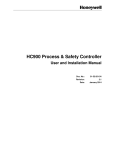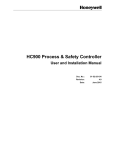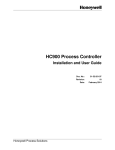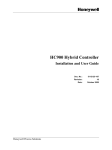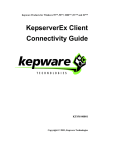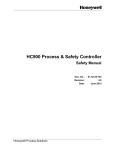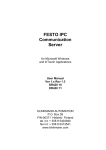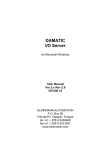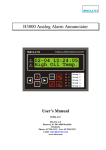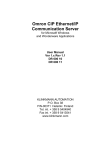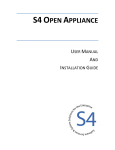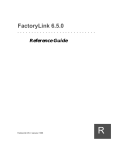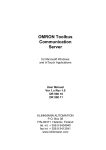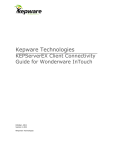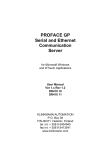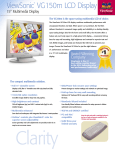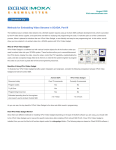Download HC900 Hybrid Controller - Lesman Instrument Company
Transcript
HC900 Hybrid Controller When you need more than just discrete control Kepware OPC Server for HC900 – Product Note Background OPC™ (OLE for Process Control™) is an emerging software standard that defines common interfaces for easier data exchange between industrial equipment (such as controllers, PLC’s, or data recorders) and Windows-based applications. The application of OPC standard “client” and “server” interfaces eliminates the need for software packages to have a direct Modbus/TCP driver interface for HC900. The Honeywell HC900 Ethernet OPC Server from Kepware utilizes a setup wizard for “automatic tag generation” that allows data to be selected for an application by default tag names rather than modbus addresses, reducing third party software database development time. In many software application packages, the HC900 OPC Server tag list is browsed and selected parameters are simply added to the database. OPC data exchange takes care of the rest! Bottom Line - Kepware’s OPC Server for HC900 allows most popular HMI, SCADA, and historian software packages plus custom interfaces using Visual Basic to easily access most HC900 data by default tag name, expanding HC900’s open connectivity. Kepware OPC Server with HC900 Ethernet driver OPC Client interface Defined by OPC Standard Modbus/TCP protocol Router Ethernet Client interface To Wonderware InTouch (via FastDDE/ Suitelink interface Ethernet OPC Client interface Switch Client interface To Intellution IFix (via PDB interface Fig. 1 Client-Server Architecture for Kepware HC900 OPC Server The HC900 OPC server from Kepware allows communication of data from one or more HC900 controllers to one or more concurrent software applications having compliant OPC “client” interface capability. The Kepware server (known as KEPServerEx) also provides direct, native interface to Wonderware InTouch software via their FastDDE/Suitelink interface and to Intellution IFix software via their PDB interface. These fast interfaces to the server, developed in conjunction with the respective software vendors, are preferred over the OPC in these packages and provide similar client connectivity. HC900 tags created by the setup wizard can be selected and imported using methods familiar to users of these packages, lowering development time. Kepware’s OPC Server can communicate with a client interface locally on the same PC, over Ethernet on a different PC, or over the Internet via connection to a company network. On the HC900 network side, communications to the OPC server is via an HC900 Ethernet driver using Modbus/TCP protocol. Date: 3-17-03 1 History of OPC In 1994, a group of vendors serving the industrial market formed what is known as the OPC Foundation. The Foundation’s goal was to develop a single client/server specification that would allow any vendor to develop software and applications that could share data in a fast, robust fashion that eliminates proprietary schemes. Another Windows data transfer standard, DDE (Dynamic Data exchange), did not provide the speed and robustness required for the industrial market. Their first specification, called Data Access Specification 1.0a was released in 1996, now Data Access V2.0. Using this specification, vendors are able to develop OPC server and client software. On a more technical basis, OPC is based on Microsoft’s OLE (Object Linking and Embedding, now ActiveX), COM (Component Object Model) and DCOM (Distributed Component Object Model) technology and is available for all 32-bit Windows Operating Systems from Microsoft. COM and DCOM enable the definition of standard objects, methods, and properties for servers of real-time data from industrial control and data acquisition equipment. Additionally, OPC via an OPC Server, can provide HMI or office applications with plant floor data via Ethernet networks, remote sites, or the Internet. What are the Benefits for the Kepware OPC Interface to HC900? • Open Connectivity – customers will be able to choose from a wider variety of client software to communicate with HC900, allowing best-in-breed selection. The OPC standard has gained increasing acceptance in recent years. There are hundreds of OPC servers available today to communicate data from industrial hardware. Most popular HMI, SCADA and data acquisition software offer OPC client functionality to allow this data to be easily imported as tags within their database. This could be an HMI package such as GE Fanuc Cimplicity, Rockwell RSView 32, or OSI Systems PI data historian software, for example. In addition, the server also supports native, fast client interfaces to Wonderware InTouch and Intellution IFix with similar ease of use. • Easy Setup using HC900 Wizard – allows HC900 OPC server to be created in a few minutes for access to major control loop parameters, all set point programmer parameters, Signal Tags, and Variables by default tag name. Signal Tags and Variables will also be listed with analog and digital selections for interface as floating point or Boolean, depending on data type configured in the HC Designer configuration. • Easy Connection to Client Applications - many software package clients offer a “browsing” capability to view HC900 data groups generated by the wizard for selection and assignment as tags. Applications written in various languages can communicate easily as long as they are OPC compliant for the same version of OPC. The Kepware OPC server supports OPC Versions 1.0 and 2.0. • Client/Server architecture – the HC900 OPC Server can communicate with several client applications concurrently (such as data acquisition software and HMI packages). This can occur locally on the same PC or remotely over Ethernet TCP/IP (via Microsoft’s DCOM). • High Performance – OPC provides high data throughput between the client interface and the HC900 OPC server. Performance is preserved by an efficient implementation of the HC900 driver via the controller’s Mobus/TCP protocol. • Data Sharing Between OPC Servers – Kepware also includes their LinkMaster capability on the product CD that allows it to access and link data from other OPC servers and offer that data to any OPC/DDE client. The product provides the means of linking data between OPC servers; thus, acting as a universal bridge for OPC server/client components. Date: 3-17-03 2 OPC Data Access Overview An OPC Server is comprised of several objects related to data access– the server, the group, and the item. The OPC server object serves as a container for OPC group objects, which logically organize OPC data items. Data items represent connections to data sources within the server. These data sources consist of parameters within an HC900 controller. Data items related to the HC900, such as those related to a control loop, are organized into named OPC data groups, automatically created by the HC900 wizard. There is no external interface defined for an individual OPC data item since all access is via OPC data groups. Exception based connections can also be created between the client and the items in a group and can be enabled and disabled as needed. The OPC client can configure the rate at which the HC900 OPC server provides the data changes to the client (set typically to 500 ms). The group data items may be either read or read/write dependent on the data type. Associated with each item is a Value, Quality, and Time Stamp. Group “Loop_01” Item 1 (HCChan.HC900a.Loop_01.PV) Item 1 (HCChan.HC900a.Loop_01.WSP) Item 1 (HCChan.HC900a.Loop_01.Output) Data groups automatically created by the wizard may include different data types defined as floating point, Boolean or Word (16-bit register). Data groups may also be created for other HC900 parameters not defined by the wizard. The data items in a group share the same update time and deadbanding. OPC Server Setup for HC900 On initial installation of the Kepware OPC Server, select the Honeywell Suite from the list of drivers. This will install both the Honeywell HC900 Ethernet driver and Honeywell UDC driver. To set up the OPC Server for the HC900 will require configuring the Channel and Device Type (HC900 Controller) for a project. Tag groups will be automatically generated per wizard entries but additional tag groups can also be set up for tags not generated by the wizard. In this case, Modbus addresses will need to be known for these parameters. In most cases, the default selections for additional dialog boxes will be sufficient but it is suggested that the Help button on the dialog boxes be utilized for further descriptions of these selections in case another selection is more appropriate to the application. In addition, for automatic startup, the OPC server should set up as a service under Windows NT or 2000 (typical environments for server and client applications). Channel Setup The first step is to add an Ethernet channel using the Honeywell HC900 Ethernet driver. Date: 3-17-03 3 Select Honeywell HC900 Ethernet driver The channel is named, driver plus NIC (Network Interface Card) selected, and write optimization method (typically the default) selected. Device Setup The next step is to add a device, an HC900 controller. Assign IP address of HC900 In consecutive dialog boxes, the controller is named, IP address assigned, communications timeouts set (use defaults typically), and port number entered (use 502 default). The 32-bit data type word order, as applied to floating point data, is next selected in the New Device – Settings dialog box. The default is an un-checked box (this provides Honeywell controller standard format for 32-bit word order selection - FP B, Big Endian). However, many software packages such as Wonderware and Intellution have the reverse of this order as standard. In these cases, rather than changing it at the controller level via the HC Designer tool, you may check the box as shown below. For Wonderware or Intellution floating point data interface, check this box Date: 3-17-03 4 The next dialog box allows you to set the block transmission sizes. You may want to expand the holding register block size to 64 or above if using SP programmers and accessing segment data. Tag Generation Wizard The final dialog box is for the HC900 automatic tag generation wizard. The device wizard for HC900 provides automatic tag generation, organized in tag groups, for the OPC server based on user entries of: Number of control loops in configuration Number of Signal Tags in configuration Number of Variables in configuration Number of Setpoint Programmers in configuration plus number of segments for each programmer Consult the HC Designer configuration and enter the desired numbers for loops, Variables, Signal Tags, and SP Programmers. If SP Programmers are entered, click on Details and enter the number of segments for each programmer. Once these entries are made, the tag groups are automatically generated with default tag names (you may alter as desired). Important: The HC Designer configuration reports should be consulted as a reference for these numeric entries. The control loop number sequence is per the Block Modbus Address Report listing for loops while the Signal Tag and Variable numbering is per the Tag Information Report. The Signal Tags and Variables are listed with both float and Boolean selections to allow proper interface to the client application. The user should refer to the Tag Information report to determine the data type assignment (Digital translates to Boolean while Analog translates to Float). The user may define other tag groups and provide tag entries based on Modbus addresses. In this case, the HC900 Communications User Manual should be consulted (part # 51-52-25-111). Use the wizard-generated tag list as a guide for data formats. Date: 3-17-03 5 Tag Groups Generated For the above entries, the tag groups generated are shown below. All relevant control loop parameters are listed. Tag groups generated Tags automatically generated for Loop_01 = Read Only, = Read/Write Signal Tags and Variables Tag Groups Each signal tag or variable is listed with 2 data types for access as a float or Boolean. Consult the Tag Information report from HC Designer to determine the proper data type. The signal tags are read only while the Variables are read/write, used for data entry from a client application. Listed by number, each with selection of data type Date: 3-17-03 6 Setpoint Programmer Tag Groups All communication parameters for the HC900 setpoint programmers are listed in sub-groups – a Parameters group (for general status data and Start/Hold/Adv/Reset operation), an Additional Parameters group (includes profile number access), and Segment data groups. These groups will allow recipes to be generated in the client application and pointed to locations in the controller, or simply allow selection of profiles stored in the controller. SP Programmer Status Profile #, profile pool assignment, Aux out status, setup parameters Setup parameters for a selected segment Date: 3-17-03 7 OPC Client Interface OPC Client interfaces for software applications can detect a compliant OPC server on the local PC or on a remote PC on an Ethernet network. For remote network access, Microsoft’s DCOM functionality, used in OPC, must be configured appropriately on your PC (see Kepware’s Remote DCOM Connectivity guide on their website). Once a server is detected, the OPC Client application may “Connect” to the selected server. In many user-friendly client applications, the tag groups for the Server may be “browsed” by the client and clicked on for Tag selection. In other OPC Client applications, the data items in a tag group are viewed as a reference and entered individually as tags via text strings in the client application. The tags defined then become OPC Tags in the software application’s database. Kepware provides client connectivity examples in a document titled “KEPServerEx Connectivity Guide”, available on the Kepware website. Client software interfaces documented include: Automation Direct Lookout Direct (OPC Client) Cutler-Hammer Panelmate PC Pro (OPC Client) GE Fanuc Cimplicity (OPC Client) Iconics Genesis32 (OPC Client) Intellution FIX Dynamics and OPC Powertool (OPC Client) Intellution IFIX ( Client – write-up available 2Q03) Kepware OPC Quick Client (OPC Client) OSI Systems PI (OPC Client) Rockwell Software RSView32 (OPC Client) Siemens WINCC (OPC client) Think&Do Live (OPC Client) Wonderware InTouch (FastDDE or SuiteLink Client) Kepware also supplies sample Visual BASIC code for developing a low cost client user interface. Kepware provides a “Quick Client” to provide real-time interface to the KEPServerEx OPC Server for button on the OPC Server testing. This client supports both read and write capability. When the tool bar is selected and the OPC server found, the Kepware client application is automatically connected to the server supporting all tag groups configured. The example below shows the Loop_01 tag group selected and Item ID’s updated in Kepware’s client application. Date: 3-17-03 8 You may also create another, concurrent, Kepware Quick Client connection to simulate OPC server browsing and tag additions using the New Server , New Group and New Item selections. A typical client application might have a tag browser similar to below: tool bar Item ID for OPC tag Typical client browser window PV Item selected In the case shown above, the tag name to be added to the client application is Chan1.HC900a.Loop_01.PV. This can be either pasted directly into a tagname cell in a client tag definition dialog box or, in some cases, used as a reference for entry into the client application tagname dictionary or similarly named dialog boxes (see Kepware’s Client Connectivity Guide on the kepware.com website). Support for Wonderware InTouch and Intellution IFix In cooperation with the respective software vendors, interfaces have been developed that use the Kepware OPC server setup structure but communicate in a native, fast structure supported by the vendor software package (not OPC). This provides the most efficient means for interface to the vendor’s application by the user. For Wonderware InTouch, the interface would use FastDDE or SuiteLink. In the Tagname Dictionary setup, the user would enter the access name for the application (e.g., KEPServerEX), the topic (e.g. HC900a_Loop_01) including DDE or SuiteLink connection choice, and the item (e.g., PV) including the data type as the reference for the InTouch TagName entered. See Kepware’s Client Connectivity Guide for more detail. For Intellution, the PDB interface is utilized. See Kepware’s Client Connectivity Guide for details (to be updated to include this interface in 2Q03). Date: 3-17-03 9 Kepware OPC Server Specifications OPC Version Compliance: 1.0 and 2.0 System Requirements: Pentium 200MHz(400MHz rec.), 32MB RAM(64MB rec.), 10MB Disk space Operating Environments: Windows *95, 98, NT (SP6a), 2000,XP (NT and 2000 strongly recommended for industrial applications) Update Rates: 500-1000 ms is typical selection for HC900 (500 ms analog scan rate) Comm Support: Ethernet TCP/IP (HC900) No. of Units: Only limited by network bandwidth using Ethernet Data Access to HC900: via Modbus/TCP protocol *Windows '95 requires Internet Explorer version 4.01 or higher along with a DCOM patch which can be downloaded from Microsoft's web site. Honeywell OPC Server Part Number: 51452976-001 (Honeywell OPC Server Suite from Kepware, includes HC900 and UDC3300 drivers) References Websites: http://opcfoundation.org (official OPC Foundation website) http://kepware.com (for OPC overview, Client Connectivity Guide, Visual BASIC client interface, remote DCOM connectivity) http://content.honeywell.com/imc/pi/hybrid/hc900.stm (for general HC900 information and manuals) Manuals: Honeywell HC900 Hybrid Controller Communications User Manual, # 51-52-25-111 Date: 3-17-03 10 Glossary Name/Acronym Active X 10Base-T Name/Definition A set of technologies developed by Microsoft, largely based on OLE and COM Ethernet network using twisted pair wiring and RJ-45 connectors, used in star topologies COM Component Object Model DCOM Distributed Component Object Model Ethernet Hub Internet Modbus/TCP or Modbus TCP/IP LAN protocol defined by IEEE 802.3 networking standard (physical and data link layers). Uses CSMA/CD access method at a variety of speeds and using several different media A hardware device with multiple ports enabling one device to be connected to several others A system of networks (local, regional, national, and international) linked by the TCP/IP protocol suite that function as single, cooperative, virtual network. Variant of Modbus protocol Date: 3-17-03 Most popular Ethernet standard. In the name 10Base-T, the “10” refers to 10 Mbps transmission speed, the “Base” refers to Baseband, which means that no frequency multiplexing is applied, and the “-T” refers Twisted Pair conductors in the cable. Component Object Model provides interfaces and inter-component communication. Through COM, an application may use features of any other application object. COM is the core of DCOM, Active X, and OLE. An extension of COM to support objects distributed across a network 10 or 100 Mbps, Baseband network that uses various media (twisted pair, thick coax, thin coax, or fiber optic cable). Example: 10Base-T is 10 Mbps Twisted Pair. A hub forwards all messages on one of its ports to all of its other ports with no isolation between devices. Modbus/TCP is a derivative of related Modbus RTU protocol used with RS232/RS-485 data acquisition and supervisory structures. Basically, Modbus/TCP encapsulates Modbus RTU frames in TCP frames for transport over an Ethernet network. An object is some function that produces a defined output, given that the input meets predefined parameters Object OLE Comments Object Linking and Embedding A technique that allows users to create objects with one application and then link or embed them in a second application. Embedded objects retain their original format but are linked to the application that created them. 11 Protocol Router Switch TCP/IP Date: 3-17-03 A system of rules for communicating over a network. A device that is capable of filtering messages based on IP addresses. A multi-port Ethernet device that switches traffic between two or more network segments on an addressselective basis. Also called switching hubs. Transport Control Protocol/Internet Protocol An Ethernet switch looks like a hub, but unlike a hub automatically determines and remembers where an Ethernet device is located and routes messages only through the appropriate port. This minimizes network loading and enables true deterministic communications over Ethernet by eliminating “collisions”. Transmission Control Protocol (TCP): - Operates at the Transport Layer of the OSI Model. - manages connections between computers. Internet Protocol (IP): - operates at the Network Layer (one step below TCP) - defines how data is addressed (source/destination) 12













